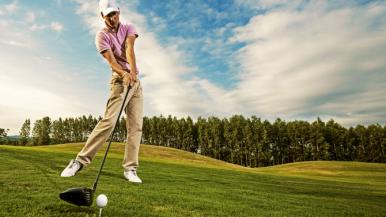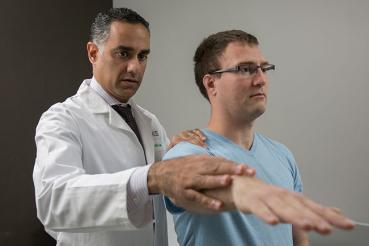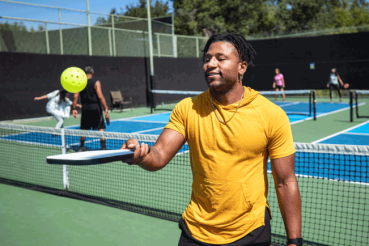If you think of golf as a low-impact sport, you might be surprised by a study published in the British Journal of Sports Medicine that found nearly 60% of amateur golfers will injure themselves at least once while playing the game.
Preventing injuries requires a little time and effort, but it can keep you on the course in the long run.
The most common golfing injuries occur in the elbow, shoulder, wrist, back and abdominal muscles, says Rush Orthopedics sports medicine surgeon Nikhil Verma, MD. No matter where the injury, the cause is likely to be overuse.
"Golfing injuries are almost always a result of repetitive motion that increases the loads on tendons or muscles," he explains. When you swing a golf club a few dozen times, you're stressing the same muscles, tendons and joints over and over.
Verma offers the following advice for protecting yourself when you hit the links:
1. Warm up with aerobics and stretching.
Before you begin a round of golf, Verma suggests a short burst of aerobic exercise — a brisk walk, a jog or even a few sets of jumping jacks — to get your muscles warmed up and working.
Next, move into a quick stretching routine that might include a few of the following.
- Upper body: With feet planted shoulder width apart, rotate slowly to one side, hold that position for 10 to 20 seconds, then slowly rotate to the other side. Return to center and reach straight up with both arms overhead, then bend first to the right and then to left.
- Shoulders: Hold both arms straight out to your sides and trace small circles in the air with your hands. Lower your arms and bring both shoulders up toward your ears, then pull your shoulder blades back, down and together. Reverse direction, rolling your shoulders forward.
- Hamstrings: Hold a golf club behind your shoulders with your hands on the end and head of the club. Stand in front of a step and place your right heel on the step, bending both knees slightly. Fold forward at the hips, keeping your spine straight. Rotate your back and shoulders slowly to the left and right. Repeat with your left heel on the step.
- Back: Stand facing the back of a straight chair with your feet apart. Place your hands on top of the chair and lean down, pulling your hips back and keeping your spine straight.
2. Start off slow and easy.
Never rush into a round of golf, Verma says, especially if you haven't played for a while.
He suggests hitting some practice balls on the driving range before starting a round, pacing your swings the way batters do when warming up in a baseball game.
"A baseball player will use a lighter-weight bat for several warmup swings, and will also do many half-swings and three-quarter swings," he says. You can do the same by taking practice swings, starting with your wedges or high irons, then working up to your normal full swing with a driver.
A program of regular exercises can help you stay healthy by strengthening the areas that are most prone to golfing injuries.
3. To get stronger, get with the program
A program of regular exercises can help you stay healthy by strengthening the areas that Verma says are most prone to golfing injuries. These are some good examples:
- One exercise that can help prevent tendonitis of the elbow, or medial epicondylitis — known as "golfer's elbow" — is squeezing a tennis ball repeatedly for five minutes at a time, alternating hands, to strengthen the muscles in your forearms. Stronger forearms can also help prevent wrist strain.
- Ward off shoulder tendonitis and rotator cuff problems with a shoulder conditioning program that includes both stretches and strengthening exercises. Try the crossover arm stretch:
- Relax your shoulders and gently pull one arm across your chest as far as possible, holding at your upper arm. Hold for 30 seconds and then relax for 30 seconds before repeating with the other arm.
- Oblique strains can turn into nagging injuries that keep you off the golf course for weeks. Prevention requires building strength in these muscles with exercises like bicycle crunches, planks and side planks.
- Back injuries in amateur golfers tend to happen in older players who have the beginnings of arthritis, says Kern Singh, MD, a spine surgeon with expertise in minimally invasive spine and back surgery. "Improper swing mechanics can aggravate a degenerative condition like arthritis," he explains, "and cause you to start feeling symptoms even if you weren't feeling them before." Singh recommends yoga or Pilates to improve overall flexibility and strengthen the core muscles that support the spine. "Power is derived from flexibility," he says, pointing out that today's professional athletes regularly do yoga to stay in top form.
Treatment to get back in the swing
If you're in pain while playing, it's important to see a specialist to properly diagnose your condition. You and your doctor can then determine the best course (pun intended) of treatment.
Depending on the underlying issue, treatment options may include one or more of the following:
- Rest, ice, compression and elevation (RICE). It is generally best to discontinue golf, at least for a short period of time, until symptoms resolve. The vast majority of overuse injuries resolve with RICE treatment.
- Non-steroidal anti-inflammatory medications (NSAIDs), cortisone injections to help reduce swelling and pain.
- Physical therapy to strengthen the muscles surrounding the joint or spine, and improve range of motion.
- Mechanical support devices, such as a knee brace.
- Biologic injections, including platelet-rich plasma (PRP), bone marrow aspirate stem cell concentrate (BMAC) and amniotic injections, a newer therapy being studied at Rush. Many people with mild arthritis can get relief from their pain with biologics, allowing a continued active lifestyle prior to the need for joint replacement.
- Cartilage restoration procedures, such as microfracture and cartilage transplant, can help reduce pain and increase function by restoring the joint's natural anatomy. At the same time, the procedure may delay the need for a more invasive procedure, particularly those considered too young to undergo total joint replacement. Most commonly performed in the knee, cartilage transplantation may also benefit patients with early joint damage in the shoulder, elbow and ankle.
- Arthroscopic surgery to repair injuries, such as labral, ACL, rotator cuff and meniscus tears, and remove bone spurs.
- Joint replacement. While it sounds extreme, hip or knee replacement may be the best option for golfers with osteoarthritis whose pain is affecting their daily life and who haven't benefitted from conservative therapies. Studies have shown that golfers who had hip or knee replacement were able to play golf at around five months post-surgery, and recovery times can potentially be even shorter — weeks instead of months — with less invasive joint replacement procedures. According to Rush Orthopedics hip and knee specialist Denis Nam, MD. "After a joint replacement, many golfers can rotate more comfortably during their swing process. With the absence of pain, they may see improved swing speed and in turn, overall improvements in their game."
Golfing after spine surgery
With such a high percentage of golfers sustaining injuries during their playing years, it was surprising to Singh that there are no official guidelines for when golfers can safely return to play after spinal surgery.
In 2016, Singh and his colleagues at Rush launched a study that uses 3D motion analysis to quantify golfers' swing mechanics before surgery and again at six weeks, three months, six months and one year post-surgery.
"So far, we're seeing that patients' swing speed and amount of force is greater than we might have expected after surgery," Singh says. "People enjoy a much better range of motion and more strength than we anticipated, and were able to return to play pretty quickly after their procedures."
Those observations reinforce another study led by Rush Orthopedics spine surgeon Frank Phillips, MD, that looked at return to golf after lumbar fusion. Phillips and his colleagues found that more than 50% of golfers return to on-course play within one year of lumbar fusion surgery. And that the majority of golfers can return to preoperative levels in terms of performance (handicap) and frequency of play.
These studies will help surgeons set post-surgery expectations for their patients and might even contribute to nationwide guidelines for when it's safe to return to play after surgery.




